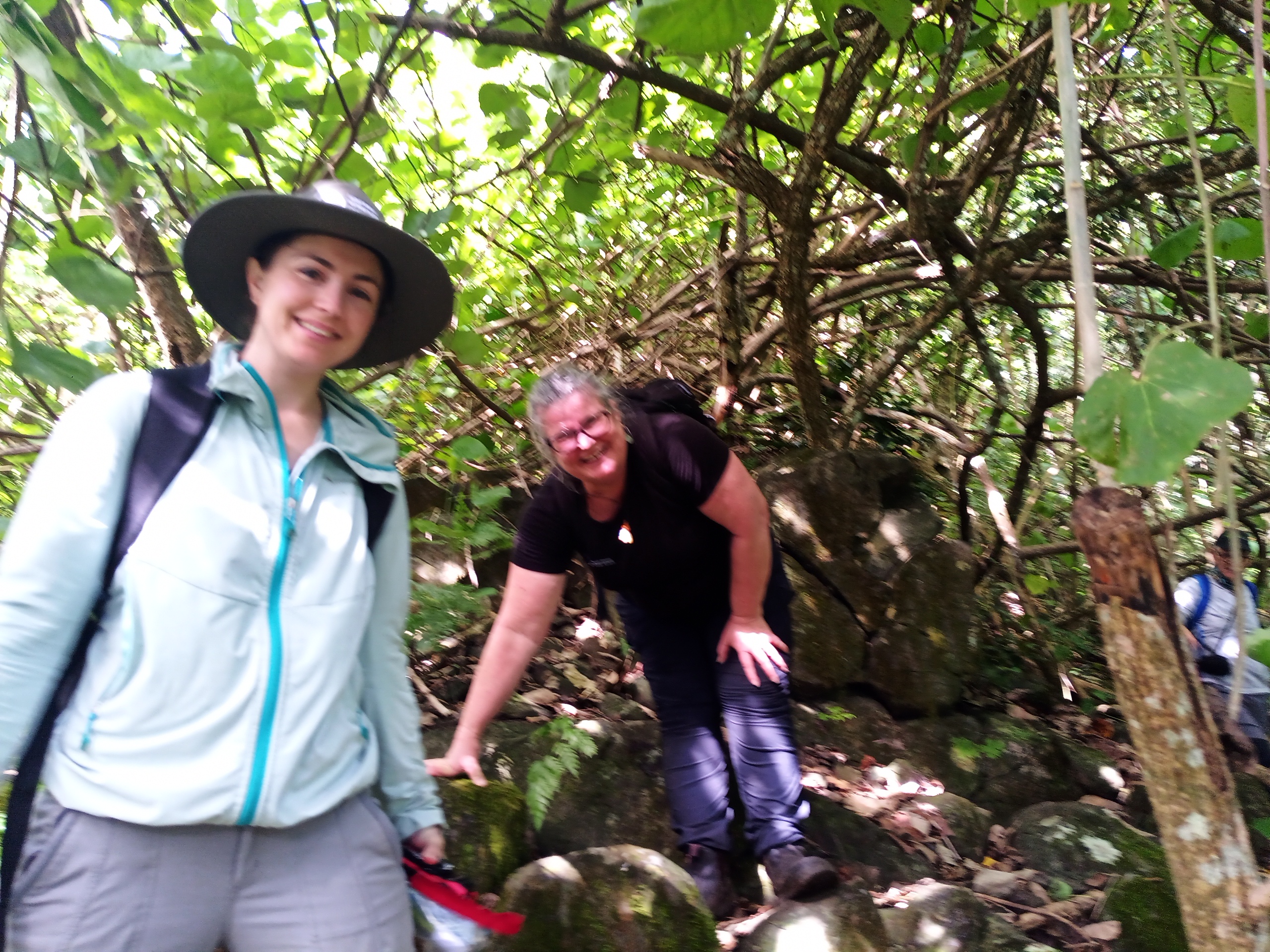Te Ipukarea Society : Update on the bio-control of the Grand Balloon vine on Rarotonga
Saturday 29 July 2023 | Written by Te Ipukarea Society | Published in Environment, National

Visiting scientists Stephanie Morton and Alana Den Breeyen on Tereora Hill. 23072840
Te Ipukarea Society recently guided some visiting scientists from New Zealand up to Tereora Hill to observe any unexpected impacts of an introduced bio-control agent. This article is written by one of those scientists, Alana den-Breeyen.
In November 2013, a weed biocontrol programme, funded by New Zealand Ministry of Foreign Affairs and Trade (MFAT) Partnership Fund, began in the Cook Islands. The partnership between Manaaki Whenua – Landcare Research (MWLR) and the Cook Islands Ministry of Agriculture, with assistance from the Cook Islands National Heritage Trust targeted the six highest priority weeds for bio-control. These included Xanthium pungens (Cocklebur), Mikania micrantha (mile-a-minute weed), Cardiospermum grandiflora (grand balloon vine), Passiflora rubra (red passionfruit), Spathodea campanulata (African tulip tree), and Psidium cattleianum (strawberry guava).
Grand Balloon vine is native to South America. Initial bio-control work undertaken in South Africa, where balloon vine is also invasive, indicated that a South American rust fungus Puccinia arechavaletae caused lots of symptoms on the leaves and only infected balloon vine, so not a risk to any other plants.
The rust fungus was thought to be a good agent for the balloon vine in the Cook Islands.
There are no Cardiospermum species native to the Cook Islands. To make sure that the rust fungus did not cause symptoms on any native plants in the Cook Islands, additional host range testing was done by MWLR in Auckland on all three Cook Island native Sapindaceae (Soapberries), and confirmed that the fungal biocontrol agent was safe for release on Rarotonga.
So what are rust fungi?
Rust fungi are obligate plant pathogens meaning that they can only grow on and infect living plants.
Plants with severe rust infection may appear stunted, yellowed, or may display signs of infection such as rust fruiting bodies (pustules). Rust fungi get their name because they are most commonly observed as deposits of powdery rust-coloured or brown spores on plant surfaces.
Most of the fungi that have been used for classical biocontrol of weeds are rusts. Rust fungi are particularly useful as biocontrol agents as they cause lots of disease on their host plant, are highly host specific, and produce lots of spores that spread readily. None of the rust fungi (or other fungi) released as classical biocontrol agents for invasive weeds have caused unpredicted damage to a non-target plant.
The Balloon Vine rust fungus was released on Rarotonga in December 2017.
By the time the MWLR team returned three months later in March 2018 to see if the rust fungus had established on the Balloon Vine, they found that the agent had spread throughout Rarotonga with impressive (devastating) impact on Balloon Vine and within six months, 90 per cent decrease in Balloon Vine cover at specific photo points was seen.
Within two years after the releases, the total percentage cover of the vines at the 20 release sites declined from over 75 per cent to under 30 per cent.
The impact of the rust fungus on the decline of the Balloon Vine in Rarotonga has benefited the restoration of native plants, and crops and sometimes the exotic plants, all depending on what was being smothered!
Post release monitoring of bio-control agents, where we check if the agent has worked and that there are no unwanted non-target impacts, is a key aspect of determining the success of released biocontrol agents. As responsible researchers, the closest plant relatives to balloon vine in Rarotonga, Dodonaea viscosa and Allophyllus timoriensis are checked annually for any non-target symptoms of the balloon vine rust fungus.
Last week, Kelvin Passfield from Te Ipukarea Society, Rarotonga, Stephanie Morton and Alana den Breeyen from Manaaki Whenua – Landcare Research, Auckland, New Zealand, and Mike Bowie from Ministry of Agriculture, Rarotonga, climbed up Tereora Hill to see if we could find any non-target impacts.
den-Breeyen, who is a plant pathologist, confirmed that there was no observed damage to other species.
Their research so far has indicated that the Balloon Vine rust fungus is a very successful and very safe fungal biocontrol agent for Balloon Vine on Rarotonga.




































